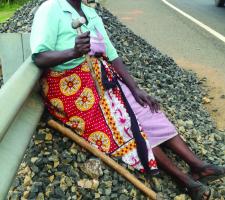
Some East African women looking to earn money to help support their family are risking life and limb crushing stones by the side of busy highways. John Njiraini reports
It is with no doubt the most dangerous spot to choose for any enterprise. Yet a few metres from a sharp bend along the Kisumu Kakamega road in western Kenya, some 365km from the country’s capital, Nairobi, is where 35-year-old Mary Madeva has chosen a spot to carry out her trade.
Going by the road guardrails, the continuous yellow line, and the steep descent because of the hilly terrain, it is obvious the stretch is a black spot. Worse still, motorists demonstrate high levels of recklessness in observing the speed limits on the newly rehabilitated busy road.
Oblivious to the danger, heavily pregnant Madeva is busy crushing stones for ballast. Next to her, her two-and-half-year-old son, Derrick Ongango, eats a piece of sugarcane with the innocence of a child who does not understand that disaster could strike at any moment.
“We choose spots along the busy road to get customers,” says the mother of four who has been crushing stones for six years, adding that safety is the least of her concerns. “I do it here to feed my children.”
Welcome to the unconventional world of the women stone crushers of East Africa. Due to abject poverty and the desperate need to earn a living, women in Kenya, Uganda and Tanzania have ventured into the trade of crushing stones into ballast that has traditionally been associated with men.
Poverty among women in East Africa, and Africa as a whole, is endemic. United Nations data shows that around 44% of women in the continent live in penury. The situation is worse for widows who have to toil for their children single-handedly.
For the women in the stone-crushing enterprise, the majority of whom are widows, it is a life of sweat, sore palms and red eyes as they sit for hours crushing stones to accumulate enough ballast that, tragically, they then sell to middlemen for a song.
Although they are not recognised, let alone celebrated, the women are playing a role in driving the booming building and construction industry that recorded a growth of 8.6% in 2017 according to Kenya’s Economic Review 2018. The sector is maintaining an impressive performance after expanding by 6.1% in the second quarter of 2018.
Due to the efforts of these women, the construction aggregates industry continues to be supplied with low-cost materials, in the process contributing to the building of relatively affordable houses mainly in rural areas, where the majority of the population depend on the ailing agricultural sector.
“Traditionally this is a man’s job but many women in this village do it to earn a living,” explains Miriam Agida, 66. A widow, Agida has been in the stone-crushing trade for “donkey’s years”.
She adds that in Vihiga County alone, there are about 1,500 women engaging in the business of stone crushing, an enterprise that is widely popular among women in most parts of western Kenya, despite the fact that many consider it to be a man’s job.
Across East Africa, about 60,000 women are directly earning a living from the trade and the number is projected to increase in the coming years as declining arable land due to population growth and climate change continues to have adverse impacts on the agricultural sector which for years has offered women a lifeline.
Unfortunately, the job of crushing stones is tough and dangerous for the women and the earnings meagre. To start with, the women are forced to go to quarries to source for stones. In the quarries, they are often at risk of sexual abuse or rape, the latter of which is said to contribute to the high rate of children born out of wedlock.
If they are lucky to come out of the quarries unscathed, the women must make sure the stones are broken into transportable sizes and hire young men to transport them to their respective spots along the road.
“The women pay me and others to harvest the rocks in the quarries and deliver them at the spots where they do the crushing,” says Wycliffe Odemu, 33.
The women then sit down to work, crushing the stones to ballast for hours every day. This they do manually, with a sledgehammer and shovel as the only tools.
On average, it takes about five days to crush enough ballast to fill a half-tonne pickup truck and it can take up to two weeks to crush enough to fill a three-tonne canter truck.
Being at the mercy of middlemen means the women are badly exploited, earning a paltry US$10 for the half-tonne truck and $30 for the three-tonne truck.
The middlemen make a killing without breaking a sweat because they sell the material to retailers at $15 per tonne who in return sell to consumers at $18 per tonne.
“Poverty has condemned us to this life,” states Agida, who has been trying to mobilise the women into groups to give them a voice against the middlemen. She says she saves little amounts through table-banking models and pushes for help from both the county and national governments.
Table banking is a strategy whereby members in a group meet once every month, place their savings, loan repayments and other contributions on the table then borrow from them immediately.
However, the fact that earnings are meagre has made it impossible to formalise the groups because for the women it’s a case of a hands-to-mouth vicious cycle.
Indeed, this has even made it impossible for the women to save enough to invest in basic ballast crushing machines, some of which cost as little as $900 on e-commerce platform Alibaba.
“A group methodology provides the best channels for financial institutions to help empower women. Coming together and saving makes it easy to offer them loans,” says Mary Munyiri, Kenya Ecumenical Loan Fund (ECLOF) chief executive officer.
She adds that being a microfinance bank that has 60% of its presence in rural areas, ECLOF is dedicated to women’s empowerment and that is why it offers water, sanitation and hygiene loan products.
In Kenya, the national government is now appreciating the role of women stone crushers and other informal aggregates suppliers in the building and construction sector.
“Informal suppliers of materials like stone, hardcore and ballast from quarries are essential in the sector,” says John Omenge, principal secretary in the State Department of Mining at the Ministry of Petroleum and Mining.
He adds that for this reason, the government has initiated measures to formalise the artisanal and small-scale mining sector. The government has also come up with policies to ensure the players in the sector operate in a conducive environment, are provided with the right tools and protective gear and earn a better return for their labour.
“One of the most important aspects of the reforms we are initiating is to eliminate middlemen in the supply chain,” says Omenge.
For Madeva, Agida and other women in the stone-crushing enterprise, this is crucial. Apart from the myriad of dangers they face, the women are also exposed to health risks and complications, common of which are chest pains, eye problems, irritable skin, muscle pains and even miscarriage for pregnant women.
“I know I am putting my unborn baby in danger, but what alternative do I have?” says Madeva.
Despite the odds against them, the majority of these women are optimistic about better days ahead. With the Kenyan government promising to formalise the sector, and the demand for building materials expected to increase substantially after the government earmarked investing in affordable housing as one of the ‘Big 4’ agendas, they hope good tidings will come their way.
“We hope the government can source for ballast from us. This will go a long way in transforming the lives of many poor women,” notes Agida.
Over the next four years, the Kenyan government is targeting to provide at least 500,000 affordable houses, a move that is expected to significantly drive demand for construction aggregates and other building materials.
Government data indicates that Kenya requires a supply of 200,000 affordable units every year until 2022 owing to a housing deficit of two million units. To realise this goal, the country needs to invest a staggering US$22.3 billion.











